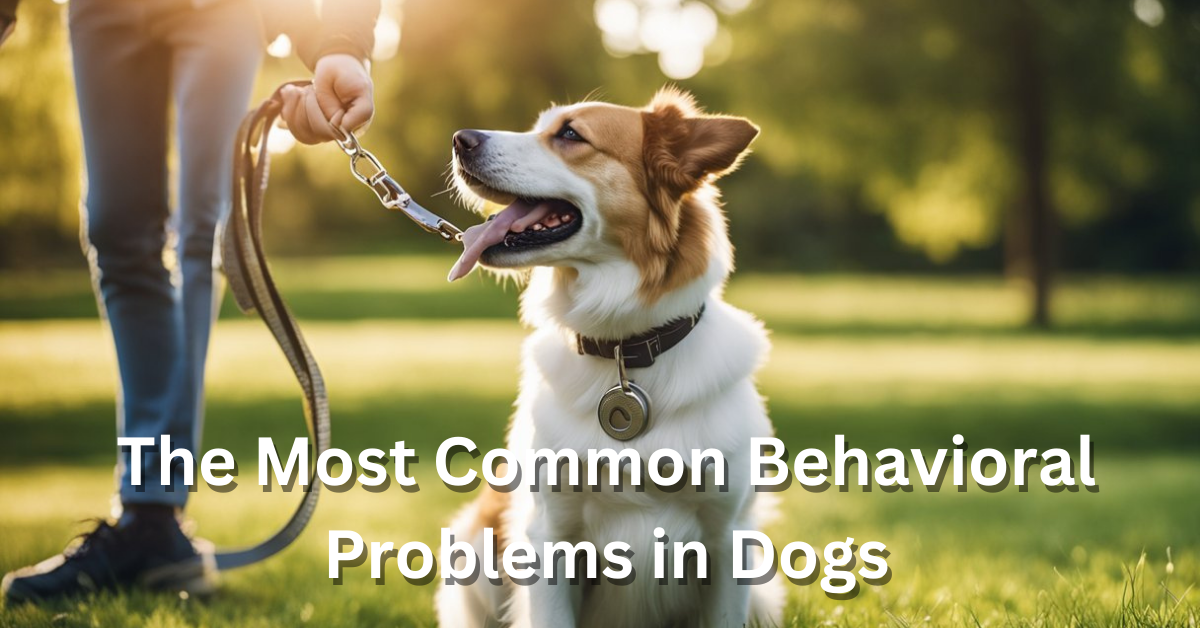The Most Common Behavioral Problems in Dogs: Identifying and Addressing Them
Behavioral problems in dogs are a common issue that many pet owners face. These problems can range from mild to severe and can cause a lot of frustration and stress for both the dog and the owner. Understanding the most common behavioral problems in dogs can help pet owners identify and address these issues early on, before they become more serious.

One of the most common behavioral problems in dogs is separation anxiety. Dogs with separation anxiety become anxious and distressed when left alone, often resulting in destructive behavior such as chewing, scratching, or digging. Another common problem is aggression, which can be directed towards other dogs, people, or even objects. Aggressive behavior can be dangerous and should be addressed by a professional trainer or behaviorist. Other common behavioral problems include excessive barking, jumping up on people, and inappropriate elimination.
Identifying Behavioral Problems
Dogs are known for their loyalty and affectionate nature, but like any other animal, they can exhibit behavioral problems. Identifying these problems early on can prevent them from escalating and becoming more difficult to address. Here are some common behavioral problems in dogs and how to recognize them:
Recognizing Aggression
Aggression is a common behavioral problem in dogs and can be exhibited in different forms, such as growling, biting, snarling, or snapping. Dogs may become aggressive due to fear, territorial behavior, or lack of socialization. Aggression can be dangerous and should be addressed immediately. Signs of aggression in dogs include:
- Raised hackles
- Stiff body posture
- Growling or barking
- Lunging or biting
Understanding Anxiety
Anxiety is another common behavioral problem in dogs and can be caused by a variety of factors, such as separation anxiety, fear of loud noises, or a lack of exercise. Dogs with anxiety may exhibit destructive behavior, such as chewing on furniture or excessive barking. Signs of anxiety in dogs include:
- Panting or drooling
- Trembling or shaking
- Restlessness or pacing
- Excessive barking or whining
Spotting Destructive Behavior
Destructive behavior is a common issue in dogs and can be caused by boredom, anxiety, or lack of exercise. Dogs may exhibit destructive behavior by chewing on furniture, digging holes in the yard, or shredding household items. Signs of destructive behavior in dogs include:
- Chewing or scratching on furniture or household items
- Digging holes in the yard
- Excessive barking or whining
- Aggressive behavior towards household items
Identifying these common behavioral problems in dogs is the first step in addressing them. If you notice any of these signs in your dog, it is important to address the issue promptly to prevent it from escalating.
Common Behavioral Problems
Aggression
Aggression is one of the most common behavioral problems in dogs. It can be directed towards other dogs, people, or both. Aggressive behavior can be caused by a variety of factors, such as fear, territoriality, or lack of socialization. It’s important to identify the underlying cause of the aggression and address it accordingly. Some common forms of aggression in dogs include growling, biting, snapping, and lunging.
Barking
Barking is a natural behavior for dogs, but excessive barking can be a problem. It can be caused by boredom, anxiety, or territoriality. It’s important to identify the cause of the barking and address it accordingly. Some common methods for reducing excessive barking include training, exercise, and environmental enrichment.
Chewing
Chewing is another natural behavior for dogs, but it can become a problem when they chew on inappropriate objects, such as furniture or shoes. It can be caused by boredom, anxiety, or teething. Providing appropriate chew toys and training can help redirect their chewing behavior.
Digging
Digging is another natural behavior for dogs, but it can be destructive when they dig in inappropriate areas, such as flower beds or under fences. It can be caused by boredom, anxiety, or a desire to escape. Providing appropriate exercise and environmental enrichment can help reduce their digging behavior.
Food Guarding
Food guarding is a common behavioral problem in dogs. It can be directed towards other dogs, people, or both. It can be caused by fear, territoriality, or a history of resource deprivation. It’s important to identify the underlying cause of the food guarding and address it accordingly. Some common methods for reducing food guarding behavior include training and desensitization.
Causes of Behavioral Problems

Health Issues
Some behavioral problems in dogs may be caused by underlying health issues. For example, a dog may become aggressive due to pain or discomfort caused by an injury or illness. Additionally, certain medical conditions like thyroid imbalances or brain tumors can also cause behavioral changes in dogs. Therefore, it is important to rule out any potential health issues before addressing behavioral problems.
Lack of Training
Another common cause of behavioral problems in dogs is a lack of training. Dogs that have not been properly trained may exhibit unwanted behaviors, such as jumping on people, chewing on furniture, or barking excessively. Owners should ensure that their dogs receive adequate training and socialization to prevent these issues from occurring.
Environmental Factors
Environmental factors can also contribute to behavioral problems in dogs. For example, dogs that are kept in small or cramped spaces may become anxious or aggressive. Similarly, dogs that are exposed to loud noises or other stressful stimuli may develop behavioral issues. Owners should provide their dogs with a safe and comfortable environment to minimize the risk of behavioral problems.
Boredom and Lack of Stimulation
Finally, dogs that are bored or lack stimulation may develop behavioral problems. Dogs that do not receive enough exercise or mental stimulation may become destructive or develop other unwanted behaviors. Owners should ensure that their dogs receive enough physical and mental exercise to prevent these issues from occurring.
Preventing Behavioral Problems
Proper Training
Proper training is essential in preventing behavioral problems in dogs. It is important to start training your dog from a young age and to use positive reinforcement techniques. This will help your dog learn good behavior and prevent bad habits from forming. Consistency is key when it comes to training, so make sure everyone in the household is on the same page.
Regular Exercise
Regular exercise is crucial in preventing behavioral problems in dogs. Dogs need physical activity to burn off excess energy and to stay healthy. Without enough exercise, dogs can become bored, restless, and destructive. Make sure to provide your dog with daily walks and playtime to keep them happy and healthy.
Mental Stimulation
Mental stimulation is just as important as physical exercise in preventing behavioral problems in dogs. Dogs need mental stimulation to keep their minds sharp and to prevent boredom. Provide your dog with puzzle toys, training games, and interactive playtime to keep their minds active and engaged.
Regular Vet Check-ups
Regular vet check-ups are important in preventing behavioral problems in dogs. Some behavioral problems can be caused by underlying medical issues, so it is important to have your dog checked out by a vet regularly. Make sure your dog is up-to-date on all vaccinations and is receiving proper preventative care.
Remember, preventing behavioral problems in dogs requires a combination of proper training, regular exercise, mental stimulation, and regular vet check-ups. By following these guidelines, you can help your dog stay happy, healthy, and well-behaved.
Addressing Behavioral Problems
Behavior Modification Techniques
One of the most effective ways to address behavioral problems in dogs is through behavior modification techniques. These techniques aim to change the dog’s behavior by rewarding desirable behavior and discouraging undesirable behavior. Positive reinforcement is often used to encourage good behavior, while punishment is used to discourage bad behavior.
Some common behavior modification techniques include:
- Counterconditioning: This involves changing the dog’s emotional response to a particular stimulus, such as another dog or a loud noise. This is done by pairing the stimulus with something positive, such as treats or praise.
- Desensitization: This involves gradually exposing the dog to the stimulus that triggers the unwanted behavior, starting with a low-intensity version of the stimulus and gradually increasing the intensity over time.
- Clicker Training: This is a form of positive reinforcement training that uses a clicker to mark the desired behavior, followed by a reward.
Professional Help
If behavior modification techniques do not work, or if the problem behavior is severe, it may be necessary to seek professional help from a dog trainer or behaviorist. These professionals have the knowledge and experience to diagnose the problem and develop a customized training plan to address it.
Medication and Supplements
In some cases, medication or supplements may be necessary to address behavioral problems in dogs. These can be used to help manage anxiety, aggression, or other issues that may be contributing to the problem behavior. It is important to consult with a veterinarian before giving any medication or supplements to your dog.
Remember, addressing behavioral problems in dogs takes time and patience. With the right training and support, most dogs can overcome their behavioral issues and become well-behaved and happy pets.
Conclusion
In conclusion, behavioral problems are common among dogs and can be caused by a variety of factors such as genetics, environment, and improper training. It is important for dog owners to be aware of these issues and take steps to prevent them from occurring. Early intervention and proper training can help prevent behavioral problems from developing and ensure a happy and healthy relationship between the dog and owner.
By understanding the signs of behavioral problems and seeking the help of a professional trainer or veterinarian if necessary, dog owners can address these issues and improve their dog’s quality of life. With patience, consistency, and positive reinforcement, these problems can often be resolved and prevented from reoccurring in the future.
Overall, being a responsible dog owner means being aware of the potential behavioral problems that can arise and taking the necessary steps to address them. With proper care and attention, dogs can live happy, healthy lives and bring joy to their owners for years to come.
Frequently Asked Questions
How can I correct my dog’s aggressive behavior?
Correcting aggressive behavior in dogs requires patience and consistency. It’s important to identify the root cause of the aggression and address it accordingly. Some common methods include positive reinforcement training, behavior modification techniques, and seeking professional help from a veterinarian or animal behaviorist.
What are some common signs of anxiety in dogs?
Common signs of anxiety in dogs include excessive barking, destructive behavior, trembling, panting, pacing, and avoidance behaviors. It’s important to identify the cause of the anxiety and address it accordingly, whether through training, medication, or other methods.
What are the most common behavioral disorders in dogs?
The most common behavioral disorders in dogs include separation anxiety, aggression, phobias, compulsive behaviors, and inappropriate elimination. These disorders can be caused by a variety of factors, including genetics, environment, and past experiences.
How can I understand my dog’s behavior with other dogs?
Understanding your dog’s behavior with other dogs requires careful observation and attention to body language. Some common signs of aggression or fear include raised hackles, growling, barking, and avoidance behaviors. It’s important to socialize your dog properly and seek professional help if necessary.
What are some bad dog behaviors and what do they mean?
Some common bad dog behaviors include chewing, digging, jumping, and excessive barking. These behaviors can be caused by boredom, lack of exercise, anxiety, or other factors. It’s important to address these behaviors through training and positive reinforcement.
What are some sudden abnormal dog behaviors to watch out for?
Sudden abnormal dog behaviors can include lethargy, loss of appetite, sudden aggression, and changes in bathroom habits. These behaviors can be signs of underlying health issues and should be addressed by a veterinarian as soon as possible.

